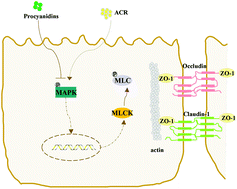Procyanidin A1 and its digestive products prevent acrylamide-induced intestinal barrier dysfunction via the MAPK-mediated MLCK pathway
Abstract
Procyanidins can alleviate small-intestine damage induced by acrylamide (ACR). However, little is known about whether procyanidins, after gastrointestinal digestion, can prevent ACR-induced intestinal barrier damage and the possible mechanism. Here, Caco-2 cells were differentiated into an intestinal epithelial cell monolayer membrane, which was stimulated with or without ACR in the presence or absence of procyanidin A1 (A1) and its digestive products (D–A1). Our findings show that both A1 and D–A1 significantly increased the transepithelial electrical resistance (TEER) value; decreased FITC-dextran 4 kDa (FITC-4 kDa) permeability, apoptosis and lactic dehydrogenase (LDH) release; and enhanced the expression of claudin-1, occludin and zonula occludens-1 (ZO-1) in ACR-induced Caco-2 cell monolayer membrane. In addition, A1 and D–A1 suppressed ACR-induced phosphorylation of mitogen-activated protein kinase (MAPK). Finally, A1 and D–A1 inhibited the myosin light chain kinase (MLCK) signaling pathway, thereby maintaining normal intestinal barrier functions, similar to the MLCK inhibitor in ACR-induced Caco-2 cell monolayer membrane. These findings indicate that A1 can alleviate ACR-induced intestinal barrier dysfunction via inhibiting the MAPK/MLCK signaling pathway, and it still has excellent inhibitory effects after digestion.



 Please wait while we load your content...
Please wait while we load your content...